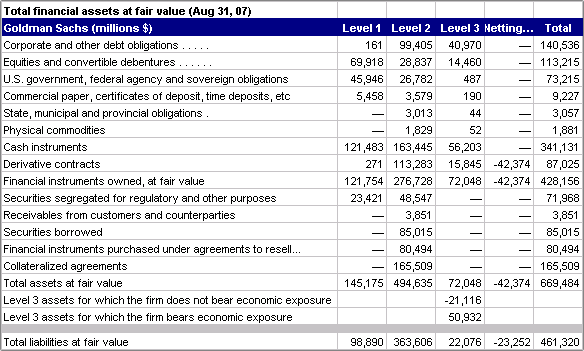|
October 17, 2007
Is Level 3 Dreaming A Nightmare In The Making?
While investors still have to wait until companies file their 10Ks to get some added color on off-balance sheet arrangements, thanks to FASB’s Statement No. 157 – which came into play at the beginning of 2007 – investors are treated to a more in-depth depiction of a company’s balance sheet on a quarterly basis. Although SFAS 157 does give companies too much leeway when estimating ‘fair value’, it is nonetheless helpful that quarterly estimates have become the norm.
Although companies have tinkered with different languages when describing 157’s fair value hierarchy, Citigroup’s latest 10Q provides a concise overview:
Level 1 – Quoted prices for identical instruments in active markets
Level 2 – Quoted prices for similar instruments in active markets; quoted prices for identical or similar instruments in markets that are not active; and model-derived valuations whose inputs are observable or whose significant value drivers are observable.
Level 3 – Instruments whose significant value drivers are unobservable.
As if to play down the word ‘unobservable’, Goldman’s interpretation of ‘Level 3’ is slightly different than that of Citigroup: ‘Prices or valuations that require inputs that are both significant to the fair value measurement and unobservable’. Goldman seems to be suggesting that so long as the ‘inputs’ are accurate fair value can be assured. Unfortunately level 3 assets are, essentially, completely illiquid.
Although a little lengthy, the following quote describes Goldman’s ‘Level 3’ thought process. The quote is from the company’s latest 10Q, and talks about how illiquid (or ‘less liquid’ – wink, wink) Level 3 OTC derivatives are valued.
“Certain OTC derivatives trade in less liquid markets with limited pricing information, and the determination of fair value for these derivatives is inherently more difficult. Such instruments are classified within level 3 of the fair value hierarchy. Where the firm does not have corroborating market evidence to support significant model inputs and cannot verify the model to market transactions, transaction price is used as the best estimate of fair value at inception. Accordingly, when a pricing model is used to value such an instrument, the model is adjusted so that the model value at inception equals the transaction price. The valuations of these less liquid OTC derivatives are typically based on level 1 and/or level 2 inputs that can be observed in the market, as well as unobservable level 3 inputs. Subsequent to initial recognition, the firm updates the level 1 and level 2 inputs to reflect observable market changes, with resulting gains and losses reflected within level 3. Level 3 inputs are only changed when corroborated by evidence such as similar market transactions, third-party pricing services and/or broker or dealer quotations, or other empirical market data. In circumstances where the firm cannot verify the model value to market transactions, it is possible that a different valuation model could produce a materially different estimate of fair value.”
Given that Goldman lumps OTC derivatives into Level 1 or Level 2 when ‘model inputs can generally be verified’, the above should simply read: ‘model inputs for Level 3 can not be verified’. Quite frankly, it is of little service to anyone that Goldman goes the extra mile to discuss input values when, by the company’s own admission, inputs are only changed when actual prices are known.
Needless to say, ‘Level 3’ fair value estimates are the least reliable and - after Goldman announced a $2.94 billion gain from level 3 derivatives in 3Q07 ($2.62 billion of which was unrealized) – they have recently started to come under attack. As Fortune appropriately asked, “Was that amount unrealized because there's no way illiquid level 3 derivatives could be cashed out at the prices Goldman attached to them?” The correct answer is probably yes, otherwise the unrealized gains would have been logged in level 2.
There should be a steady trickle of ‘level 3’-related discussion arriving as companies continue to file their Qs. And while it may take a long time before forming final judgment on fair value accounting, Goldman (one of the first to file their Q) provides a blatant example of how Level 3 estimates opens up the door for imaginative accounting.
For the record, with the trend only 3-quarters old Goldman Sachs is growing its level 3 asset base at a healthy clip. And while the company is quick to state that level 3 assets represent only 7% of total assets, what Goldman did not mention in its Q was that this number has grown from 5.2% in 1Q07. Assuming certain markets remain illiquid, investors will likely have to wait until 1Q08 for Goldman and others to explain why level 3 assets are growing faster than total assets on a year-over-year basis. Until then - or until (if) investors start worrying about level 3 asset growth - let the dreaming continue...
 |
 |
|
